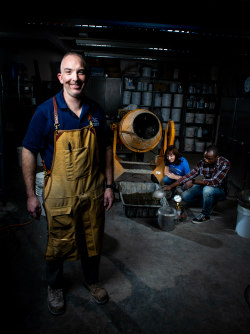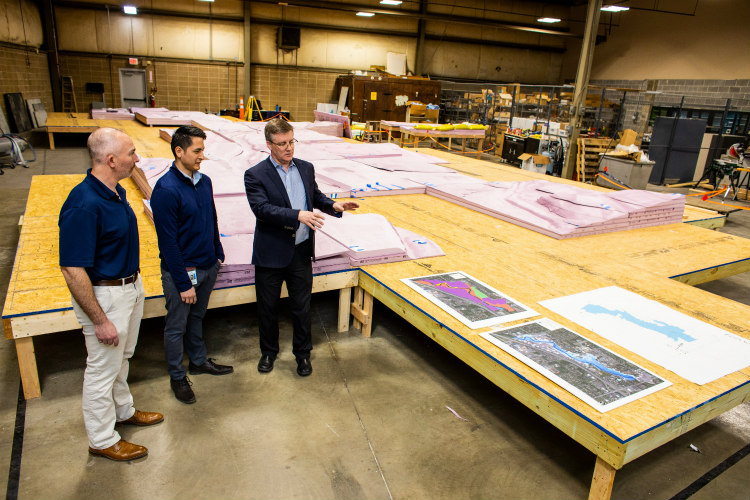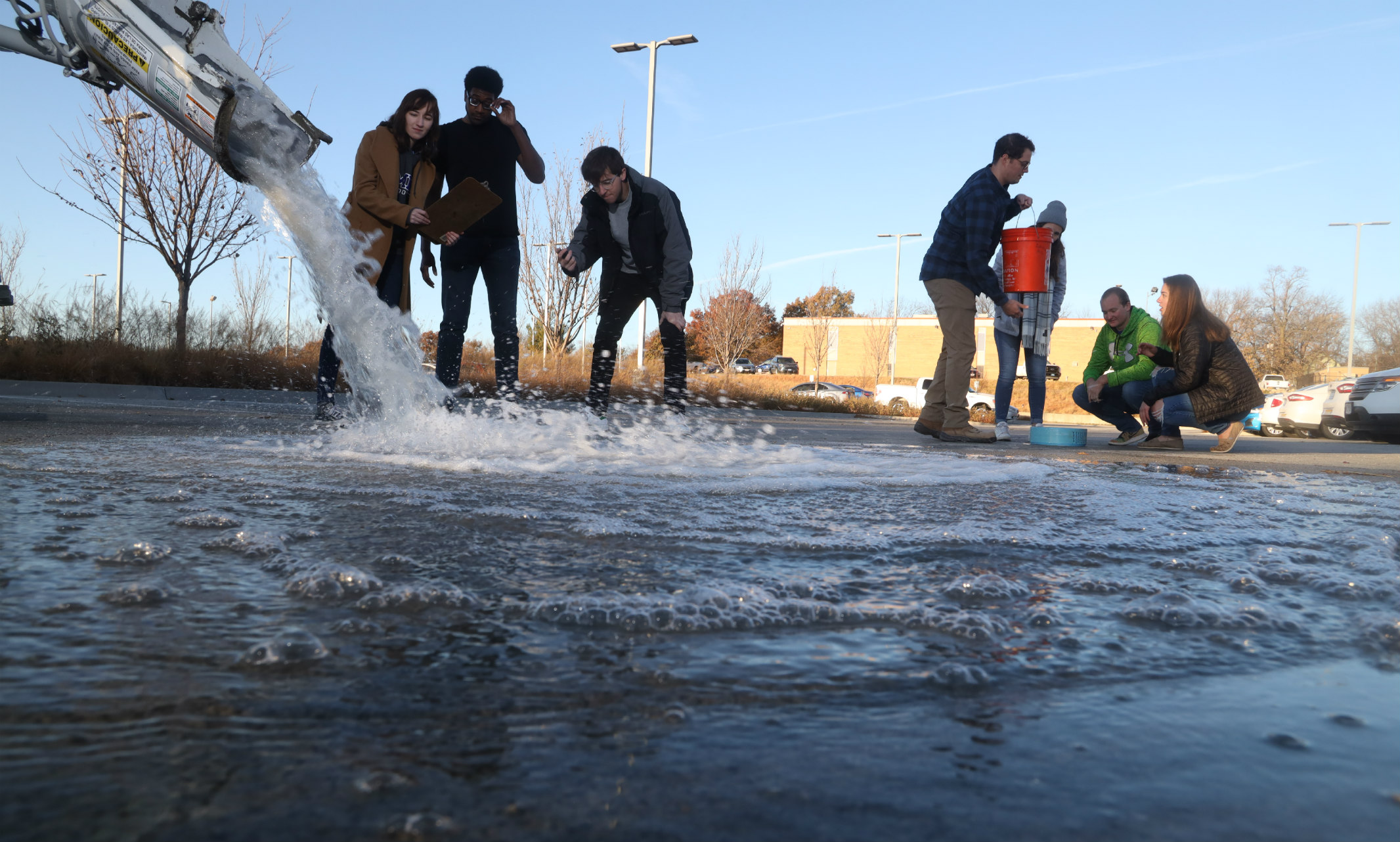Our global temperature is on the rise, oceans are warming and extreme weather events have been steadily increasing. According to NASA, “the current warming trend is of particular significance because most of it is extremely likely (greater than 95% probability) to be the result of human activity."

Kevern with students making
concrete in an SCE lab.
Luckily, humans from the UMKC School of Computing and Engineering are developing ways to make their respective areas of expertise more environmentally friendly. John Kevern, Ph.D., professor and civil and mechanical engineering department chair, has been working with SCE alumni as well as Kansas City architects, builders and concrete companies to increase the amount of pervious concrete used around the city.
Pervious or permeable concrete is a porous mixture of cement, water and coarse aggregate. The beauty of the lumpy, holey concrete that has the consistency of a rice cake is that it serves as pavement and stormwater mitigator in one. It can also help prevent floods, control erosion, allow groundwater recharge and improve water quality through filtration.
Bonus: Pervious concrete doesn’t freeze over like normal pavement. It’s less slippery since the water has a smaller surface area to freeze on. A recent $55,000 EAGER grant – which support exploratory work in early stages with opportunity for high risk-high reward – from the National Science Foundation allowed Kevern and SCE students to experiment with de-icing and slip and fall.
“For society, from an equity and access perspective, any surface where we can reduce the chance of a slip and fall makes both a safer surface and allows us to use less de-icing agents like salt. Salt is not only bad for the environment but it also reduces the lifecycle of concrete,” Kevern said of his NSF research.
Kevern, who is a member of the advisory group for the American Public Works Association’s Sustainable Stormwater Task Force, is also researching a greener way to produce the cement used in concrete by reducing the amount of carbon dioxide emitted throughout the process. Using recycled ingredients — like the byproducts of coal burning power plants or iron and steel production — in the cement mix drastically lowers CO2 emissions.
Kevern ran the numbers on CO2 in Kansas City and found that the city used 2.5 million cubic yards of concrete in 2018, which equals 663,375 tons of CO2. The average Kansas City vehicle is responsible for 10.690 pounds of CO2 each year.
That means that if you use a mix of concrete that’s made of 35% recycled byproducts, the CO2 reduction would be equivalent to taking 42,000 cars off the road. Increase to 50% recycled byproducts, and the equivalent is 60,000 vehicles.
“The production of cement for concrete is somewhere around 8-10% of the human-produced carbon dioxide in our atmosphere — there are many other things that are more but it’s not insignificant — anything we can do to replace cement and reduce the CO2 footprint of our concrete is helpful from a climate change perspective,” Kevern said.
Concrete and Beyond
The increased greenhouse gases can also account for an increase in extreme weather changes. In Kansas City, stormwater and flooding have raised an early challenge.
"Building physical models is nearly a lost art. When computers came around, everyone thought they’d take the place of physical models, but unfortunately they aren’t able to predict flooding as accurately.”
Kevern regularly works with KC Water, the city department responsible for accessibility and quality of water services around the city, including School of Computing and Engineering alumni like Tom Kimes (B.S.C.E. ’87), manager of stormwater engineering, and Jose Lopez (B.S.C.E. ’15), watershed planner.
KC Water recently installed several different types of concrete, including contracting Kevern to install pervious concrete, in the parking lot of their offices to test the long-term benefits of each. Kimes and Lopez are also working on a way to combat the longstanding stormwater and sewer issues that have plagued the city for years and will be exacerbated by the added rainfall that climate change brings.
After several years of repeated flooding from nearby Indian Creek, the City of Kansas City, Missouri, bought the land and demolished the strip mall that stood at 103rd Street and Wornall Road. The mall was home to Coach’s Bar & Grill, where two employees had to be rescued from the roof by firefighters during severe flooding in 2017.

Kevern (left) regularly partners with SCE alumni at KC Water to examine stormwater and sewer issues that have affected the Kansas City area for years. Here he is pictured with watershed planner Jose Lopez (B.S.C.E. ’15, center) and manager of stormwater engineering Tom Kimes (B.S.C.E. ’87, right) with a model they are constructing inside the KC Water building to identify various flood risks and ways to combat them.
Now, the city, along with KC Water and the Army Corps of Engineers, are building a 70 feet long by 25 feet wide physical model of the area inside a building downtown, to better identify the flood risks and how to combat them.
It’s an innovative approach. Kimes says not many places are able to produce physical models and having two experts in the city — UMKC adjunct professor Don Baker and associate professor Jerry Richardson — is especially valuable. Lopez has been working on the model since its inception – he started working on the scaling for the project while still a student at UMKC.
“Instead of something to be protected from, I’d like to see us embrace rivers as the valuable parts of our ecosystem that they are.”
Kevern agrees, “Building physical models is nearly a lost art. When computers came around, everyone thought they’d take the place of physical models, but unfortunately they aren’t able to predict flooding as accurately. I’d estimate there are less than a handful of places that have people with the knowledge and technique needed to build physical models.”
That’s not to say computers are totally out of the picture. Lopez says they will “flood the model several times to get the flow patterns, then make the computer model reflect those.”
Once the research on flooding is done, the area will become a park complete with pervious concrete, green space and information about Indian Creek.
Focusing on Stormwater Research
In May, Kevern and the School of Computing and Engineering will team up with KC Water and several other stakeholders – including FEMA, Unified Government of Wyandotte County and the Army Corps of Engineers – to launch the Center for Urban Stormwater Research. The first project the center will focus on is a FEMA grant exploring ways to educate the public about the risks of flooding.
Kimes hopes that Kansas City is able to manage stormwater in a way that leads the nation and turns the city’s “wild rivers” into community assets even with added rainfall.
“Instead of something to be protected from, I’d like to see us embrace rivers as the valuable parts of our ecosystem that they are,” Kimes says.

